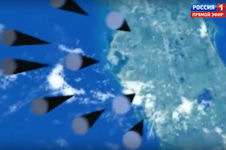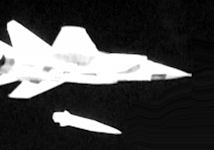Putin's 2018 Presentation
On 01 March 2018 Russian President Vladimir Putin dedicated around one-third of his nearly two-hour address to a joint session of parliament and other VIPs to descriptions and animations or other video clips of new "strategic weapons," most of which he suggested were nuclear-capable. Putin added, "Understand that everything I have said today is not a bluff... no one in the world possesses anything remotely similar ...."
All of the weapons had a substantial "Gee Whiz" quality to them, as they were unlike other weapons deployed by other countries. But there is a good reason no one else has such weapons. Of the six weapons, the Sarmat heavy ICBM is old news [the last American heavy ICBM was retired three decades ago], the Avanguard maneuvering reentry vehicle and the Combat Laser Complex are instances of technolgical exuberance with little military significance, and the other three are probably hoaxes.
During the Cold War the West was bedeviled by Soviet weapons hoaxes and disinformation. Now it looks like Moscow is up to its old tricks.
Sergey Karaganov , Dmitry Suslov argued that "the acquisition by Russia of the latest weapons, which are guaranteed to cause damage to the United States in a retaliatory nuclear strike with any quantitative and qualitative development of its strategic offensive and defensive forces in the next 10-15 years. This is primarily about hypersonic cruise missiles ("Dagger", "Zircon"), hypersonic missile systems ("Vanguard") and submarine drones with nuclear equipment ("Poseidon"). Their presence strengthens strategic deterrence (to reduce the potential of a retaliatory nuclear strike by Russia in the foreseeable future is impossible in principle) and allows it not to participate in the arms race, nor to spend money on maintaining quantitative nuclear-missile "parity" with the United States. "
With his announcement that Russia has developed new strategic weapons, including a nuclear-powered missile that he said can fly indefinitely and evade U.S. missile defenses, President Vladimir Putin grabbed the attention of policymakers, military experts, and legislators from Washington to Berlin. “We’ve really seen an about-face, particularly in the last 10 years, where the arms-control regime that we inherited from the Cold War is under severe stress,” John Baker, an analyst and strategist with the Ploughshares Fund, a disarmament advocacy group, told RFE/RL. “We’re at the beginning of a new arms race,” he warned.
But Matthew Kroenig, a professor at Georgetown University and author of the book The Logic Of American Nuclear Strategy, suggested the United States and Russia were already well into an arms race, whether or not Washington was aware of it. “Russia has been in an arms race with the United States for the past decade, and we are just now waking up to that fact. So we may be entering a new arms race, but that is not the worst possible outcome,” Kroenig said. “The worst outcome is doing nothing as an enemy builds weapons to engage in aggression against you and your allies.”
In the first part of the speech read before hundreds of senior officials and legislators, Putin was assisted by computer videos and images transmitted on giant interactive platforms in a conference room near the Kremlin. Putin promised to increase life expectancy by 10 years, increase Russia's GDP by 50% by 2025 and halve the poverty rate. At the 22nd Congress of the Communist Party of the Soviet Union in 1961, Nikita Khrushchev promised that "The current generation of Soviet people will live under communism".
In the second part of the speech, the Russian leader used interactive platforms to show Russia's latest weapons. Some of these had been unveiled to the public for the first time. Such a multi-media presentation was without precedent for the Moscow leadership. Since the 1950s, Moscow's might had been demonstrated in May Day or Victory Day parades, with flyovers of new aircraft and dragging rockets through Red Square. But the challenge facing Putin was that the advances he wished to proclaim did not lend themselves to such prosaic presentation. Arthur C Clarke observed that "any sufficiently advanced technology is indistinguishable from magic" and Putin was bumping up against Clarke's Third Law.
Sarmat RS-28 / 15A28 ICBM |
OLD GEE WHIZ A replacement for the SS-18 built by the Yuzhnoye complex, now in Ukraine. This Russian copy is built by Russia's State Rocket Center V. P. Makeyev of (Miass) and NPO Engineering (Reutov) along with NPO Mashinostroyeniya. The last such American heavy ICBM, the Titan II, was withdrawn from service in 1987, three decades ago. |
Avanguard
|
POINTLESS GEE WHIZ A boost-glide maneuvering reenty vehicle that would evade high altitude endo-atmospheric missile defense inteceptors. The United States has no plans to deploy such interceptors to defend the continental USA. |
VLK Laser "Peresvet" |
POINTLESS GEE WHIZ Yet another Russian ground-based tactical laser. Much larger than previous such lasers, it is similar to the American Tactical High Energy Laser [THEL] that performed so poorly some 15 years ago. |
9M730 Dagger |
PROBABLE HOAX A long-range [2,000 km] air launched hypersonic [+ Mach 5] cruise missile. Available imagery makes it look more like a test of a dummy air-dropped 9K720 Iskander [SS-26 STONE] tactical surface-to-surface missile. Not clear what problem it solves, apart from giving the MiG-31 a new lease on life as a theater tactical bomber. |
Nuclear powered Cruise Missile "Burevestnik" |
PROBABLE HOAX Said to be a cruise missile with a nuclear power plant with practically unlimited range, unpredictable flight trajectory and the possibility of bypassing interception lines. The claim that the reactor could fit within the American Tomahawk cruise missile, with a diameter of about 0.63 meters [21 inches] is particularly hard to swallow. |
Status-6 Torpedo "Poseidon" |
PROBABLE HOAX First deliberately "leaked" on 10 November 2015 Russian evening news programs. Such a torpedo was envisaged in 1950s, during Cold War, by nuclear physicist Andrei Sakharov. Interesting as a Doomsday Machine, should one be needed. But this really looks like disinformation. |
During a speech to the Federal Assembly on March 1, President Vladimir Putin revealed a wide range of brand new weapons systems. While the newly developed, nuclear-capable intercontinental ballistic missile was named RS-28 'Sarmat' and the hypersonic missile was dubbed 'Kinzhal' (Dagger), Putin asked the public to suggest and vote for the names of three other brand new weapon systems.
The names for the combat laser complex, unmanned underwater vehicle and cruise missile with nuclear power plant were selected during the voting on the website of the Ministry of Defense. Among the names of the combat laser complex, "Peresvet" won. "Burevestnik" was chosen as the name of the cruise missile with a small nuclear power plant, the "Poseidon" received the largest number of votes among the names of the unmanned underwater vehicle, the military department said. This is the first precedent in the history of Russia, when the name for weapons was chosen by popular vote. Previously, the military chose the names for weapons.
The underwater submarine drone was eventually named 'Poseidon', in honor of the Greek god of the seas, while the state of the art combat laser system received a proud name of 'Peresvet' – a Russian-warrior monk who fought at the Battle of Kulikovo at the end of the 14th century. The nuclear-powered cruise missile was menacingly named 'Burevestnik' (petrel seabird), which can be loosely translated from Russian as ‘storm messenger.’
The chosen names faced stiff competition during the polling period. A total of 245,000 names were suggested, from which the military selected the 50 most popular ones and brought them up for a final vote. The fiercest competition unfolded over the name of the nuclear-powered cruise missile. While 'Burevestnik' received nearly 750,000 votes, the names 'Palmyra' and 'Surprize' were breathing down its neck, banking over 700,000 votes. 'Poseidon' won the vote for the nuclear drone submarine, with over 150,000 votes, securing victory over 'Aurora' and 'Surf' that were running strong in the category. 'Peresvet' faced competition from 'Basilisk', a mythical reptile creature of European legends, which has the power to cause death with a single glance.
In an interview with NBC’s ‘Megyn Kelly Today’, Putin stressed that “every single weapon system that I have discussed today easily surpasses and avoids anti-missile defense systems.” He clarified further that while “some of them still have to be fine-tuned and worked on,” others are combat-ready. “One of them is already on combat duty. It’s available to the troops.” Deputy Defense Minister Yury Borisov made clear that some of the new systems are already in mass production and are being used by the Russian armed forces. “This is not a bluff, but a new reality,” he said.
While US officials continued to reassure public that the US still has enough nuclear and conventional might to counter Russia, earlier this week Under Secretary of Defense for Policy John Rood noted that “the missile defense system that the United States has developed and fielded today would not have the capability to negate the Russian ....strategic nuclear arsenal.” Rood reiterated Washington’s official position that US missile defense systems were never intended to neutralize either the Russian or the Chinese strategic arsenals. “That has not been our plan in focus and the capabilities developed do not enable us to do that,” he said.
The Pentagon and the CIA saw “no change” in Russia’s strategic military capability following new strategic weapons systems presentation, saying they believe that President Putin “says lots of things that are without foundation.” The five new Russian systems unveiled by Vladimir Putin “are still years away” from threatening the US, Defense Secretary James Mattis noted 12 March 2018, stressing that Russian military capabilities are unable to change the military balance in the world. “They do no impact any need on our side for a change in our deterrent posture,” Mattis said, noting that Putin’s remarks were “disappointing, but unsurprising."
Russia’s new weaponry came as no surprise to the US intelligence community either, CIA Director Mike Pompeo said on Sunday, echoing the widely accepted American reaction to the news. Pompeo instead used the opportunity to tell the American public not to worry about the unprecedented potential of the Russian strategic systems. “Vladimir Putin says lots of things that are without foundation. I don’t want to comment precisely on the details,” the CIA director said on Fox News Sunday. “We are following and tracking all of this closely, as are our brothers at the Department of Defense.... Americans should rest assured that we have a very good understanding of the Russian program and how to make sure that Americans continue to be kept safe from threats from Vladimir Putin”.
Deputy Prime Minister Yuri Borisov said 26 September 2018 that the new weapons presented by Russian President Vladimir Putin in March 2018 showed that Russia should be reckoned with. Speaking at the conference of machine builders, he said "Such works have been demonstrated to the whole world that it is necessary to reckon with Russia". Borisov added that before that, "Russian industry and the Russian defense industry, and all our achievements, to put it mildly, were underestimated all over the world -" there all the rusty, old missiles do not fly there ... ". The Vice-Premier noted that Russia today is firmly on its feet with respect to its own security. "We have very good reserves, and we are to some extent the trendsetters," Borisov said.
The Russian Claims



|
NEWSLETTER
|
| Join the GlobalSecurity.org mailing list |
|
|
|
